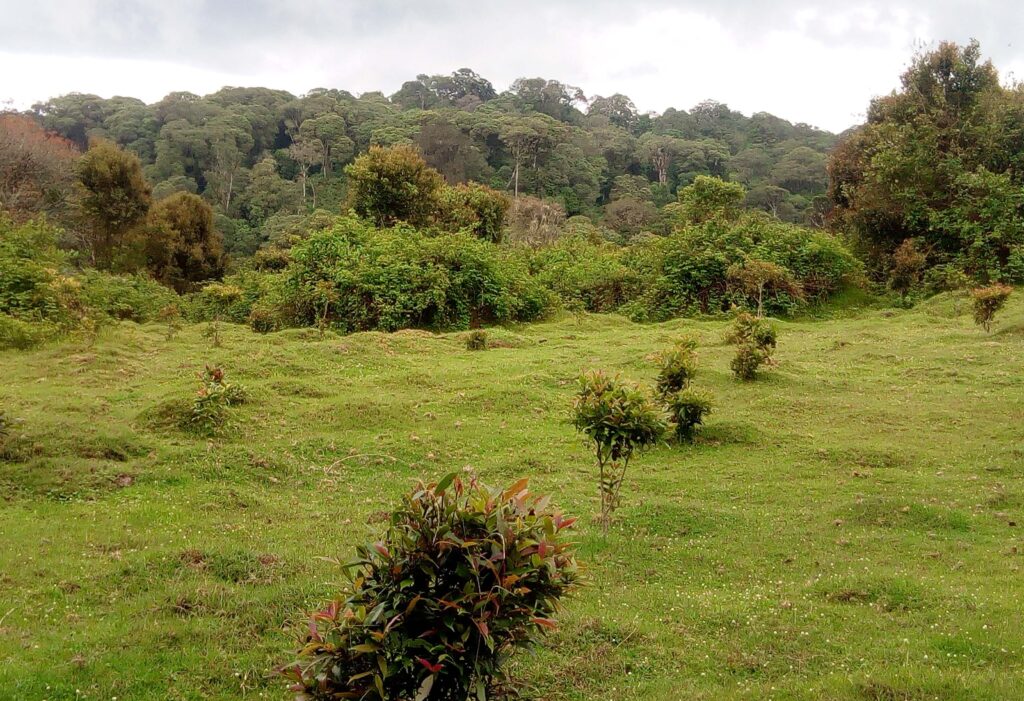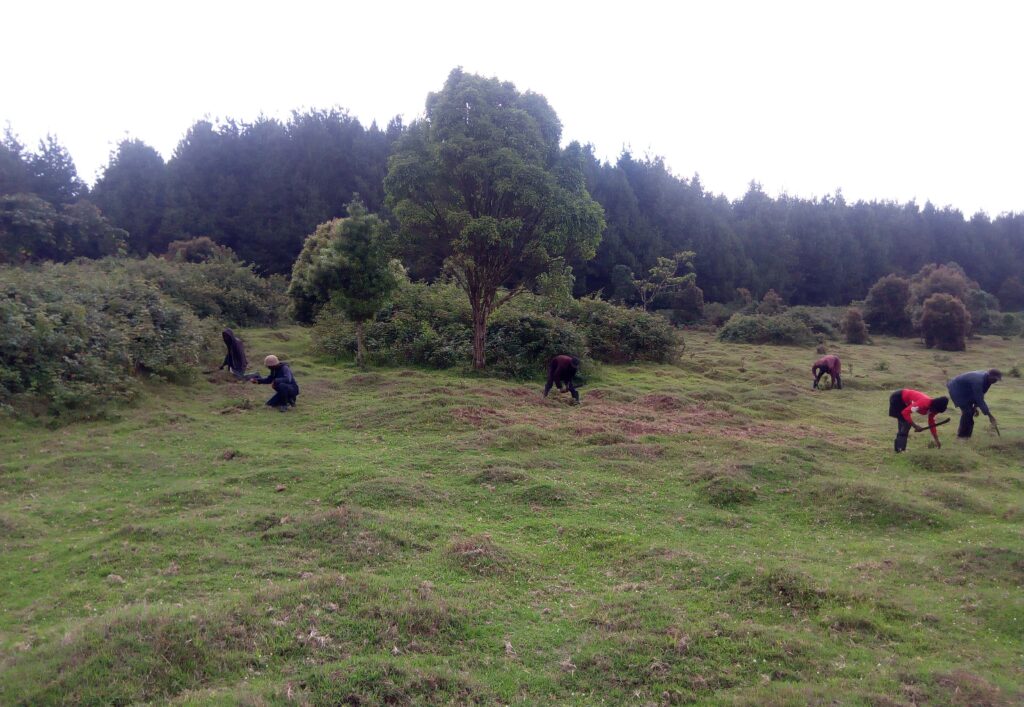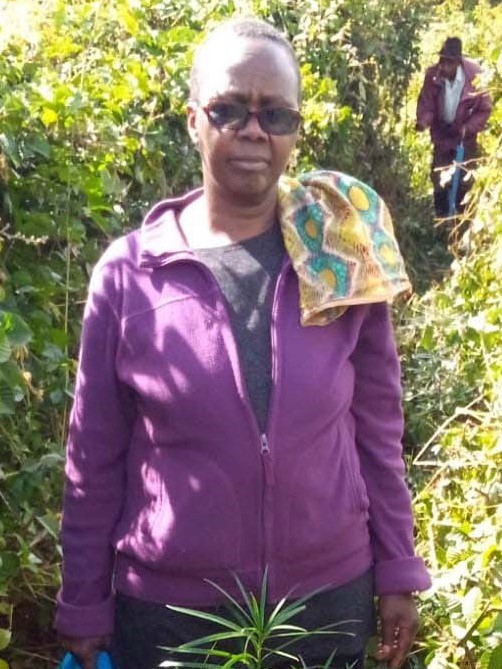Collaboration for Mount Kenya Forest Restoration

This is the first article in our seven-part Forests for Africa series highlighting our partners' forest restoration work across the continent.
By Martin Kiama and John Mwacharo
Located in Kenya’s highest mountain Mount Kenya, Mount Kenya forest covers an area of approximately 1,420 square kilometers. The forest is a crucial catchment area, providing water and other essential ecosystem goods and services to adjacent communities and the country. Mount Kenya forest is a Key Biodiversity Area (KBA), and World Heritage Site, home to many threatened animal species like the Abbott’s Starling, Kenya Jewel damselfly, and Mount Kenya Bush Viper, among others.
However, Mount Kenya forest’s rich biodiversity is faced by a myriad of threats which have seen the forest rapidly lose its cover and biodiversity due to a myriad of threats including forest fires, forest adjacent land conversion, illegal tree felling, wildlife poaching, invasive plant species and climate change.
Fortunately, efforts by 27 Community Forest Associations (CFAs), together with Nature Kenya and the Kenya Forest Service (KFS), with support from Trillion Trees, a venture by BirdLife International, Wildlife Conservation Society (WCS) and World Wide Fund for Nature (WWF) have resulted in the restoration of more than 500 hectares of degraded forest areas, with over 500,000 indigenous trees planted in the past five years. Based on the progress of the planted trees, community groups in Mount Kenya can attest to the success of the restoration initiative.
For instance, the Chehe CFA, with 768 members, majority women, manages the Chehe forest block on the border between Kirinyaga and Nyeri counties. Community members engaged in planting and maintaining the restored sites have also earned wages that have helped them improve their livelihoods.
Beatrice Nyawira Wangai, a mother of four, is one of the community beneficiaries earning a living out of forest restoration work. Wangai has been engaged in planting and taking care of the saplings. “I have been able to educate my children from the money I earn from planting and maintaining tree seedlings in Chehe. We also get paid to take care of tree seedlings in the nursery,” says Wangai. The sale of tree seedlings also generates revenue for the Chehe CFA.
“Proceeds from the sale of tree seedlings has helped us expand our tree nursery. We are now propagating bamboo, which we anticipate will earn us more than Ksh. 2 million (US$ 15,550) during the planting season,” says Geoffrey Muriithi Wandeto, Chehe CFA chairman. Wandeto further says that the restoration of Mount Kenya forest comes at the opportune moment when the Critically Endangered Mountain Bongos are being reintroduced into their natural habitat.
“Restoration efforts supported by Nature Kenya have drawn the interest of a project seeking to conserve Mountain Bongos. This project is now working with the Chehe and Ragati CFAs, bringing in more goodies to us. Two of our members are working with this project to raise Mountain Bongo conservation awareness in schools,” adds Wandeto.
The trees in the restored sites have grown to a height of between 150-200 cm. Nickson Macharia Mariga, Chehe Forest station manager, puts the young trees’ survival rate above 75 per cent. Mariga attributes the impressive survival rate to Nature Kenya’s support. “Nature Kenya has continuously supported the weeding and replacement of dead seedlings. The collaboration between the community and KFS has also been key to ensuring the survival of the saplings,” says Mariga.
Maintaining a high survival rate has not been easy, Wandeto reveals. Low rainfall and prolonged drought have presented many challenges. However, the Chehe CFA chairman is upbeat. “We, the community of Chehe, will continue forest restoration activities in Mount Kenya. Protecting the biodiversity in this area is our responsibility. We urge more stakeholders to recognize and support our restoration efforts,” adds Wandeto.

Private Sector Partnerships
Through engaging companies like Kenya Breweries Limited, Coca-Cola Beverages Africa and Safaricom PLC, Nature Kenya has secured support from companies to restore degraded forested areas in Mount Kenya, Aberdare, South and North Nandi, Sabaki River Mouth (mangrove) and Mida Creek (mangrove). Over 670,000 trees have been planted through such support from 2018 to date. Other companies supporting this initiative include Vivo Energy Kenya, Kenya Deposit Insurance Corporation and the Privatization Commission.
In 2022, Nature Kenya engaged 26 community groups to plant more than one million trees at various sites across the country, including Mount Kenya, Aberdare Forest, Taita Hills forests, Mumoni Hill Forest, Mida Creek and Sabaki River Mouth. Trees planted included indigenous, fruit and mangroves in forests, farms and along the Kenya coastline.
Efforts by Nature Kenya to partner with the private sector to restore degraded forest landscapes align with ongoing global efforts to scale up actions and commitments to urgently halt and reverse the loss of biodiversity that threatens ecosystem services on which humans and businesses depend on. “A healthy forest ecosystem fosters a productive landscape via provision of ecosystem services, including water supply, that both people and the climate benefit from. Acting now to preserve and restore forests like Mount Kenya, will be the only way for us to prevent disruption of the delicate balance of our planet’s ecosystem and jeopardizing the future of humanity and all living beings”, notes Maminiaina Rasamoelina, Forests Programme Coordinator at BirdLife Africa.
According to a white paper published by World Economic Forum in December 2022, the global goal of halting and reversing biodiversity loss by 2030 and the shared vision of living in harmony with nature by 2050 can only be possible if economic actors are active partners in the process.
Businesses depend on nature and the ecosystem services it provides. Accordingly, US$44 trillion of economic value generation – over half of the world’s total gross domestic product (GDP) – is at risk due to disruption occasioned by loss of nature. “No sector is immune to this,” warns the white paper. Last year in December, world political and business leaders converged in Montreal, Canada for the Convention on Biological Diversity (CBD) COP 15, where they adopted the Post-2020 Global Biodiversity Framework (GBF). The Post 2020 GBF seeks to awaken efforts from governments, businesses and communities to halt and reverse biodiversity loss.
The collaboration and support provided by local corporates in Kenya towards forest restoration is a step to the right direction. Following the recent CBD COP held in Montreal Canada in December 2022, global analysis pointed to a huge financing gap of US$ 700billion. To bridge this gap, calls for more private sector engagement in biodiversity conservatin initiative have been made. In this regard, following the leadership of corporates Nature Kenya is working with, far reaching conservation impacts can be achieved.
“Healthy forests support food production, water replenishment among other vital ecosystem services that support community well-being, driving local economies. We can not disregard these vital ecosystems, as this wil be detrimental to our future”, concludes Paul Gacheru, Nature Kenya Species and Sites Manager.

“I have been able to educate my children from the money I earn from planting and maintaining seedlings in Chehe.”
Beatrice Nyawira , Chehe Community Forest Association (CFA) Member